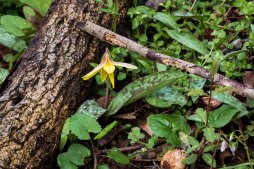 On April 11 I went hunting for two-leaf miterwort in the woods near my house. I found just a few plants, perfectly in bloom. But they were up a pretty steep slope. That steep slope used to have a lot more miterwort on it, just off the trail, but for some reason it doesn’t anymore.
On April 11 I went hunting for two-leaf miterwort in the woods near my house. I found just a few plants, perfectly in bloom. But they were up a pretty steep slope. That steep slope used to have a lot more miterwort on it, just off the trail, but for some reason it doesn’t anymore.
A lot of families were out that day; social distancing was impossible without stepping off the trail. So, it seemed best to move up the slope and set up the equipment there. On the other hand, exactly that sort of disturbance is probably why there’s less miterwort this year.
 I compromised by moving just off the trail, and using my longest lens (70-200mm) with a 1.7x teleconverter. I really wanted to get right up to the plants, and use the 105mm macro lens, but I just couldn’t let myself do it.
I compromised by moving just off the trail, and using my longest lens (70-200mm) with a 1.7x teleconverter. I really wanted to get right up to the plants, and use the 105mm macro lens, but I just couldn’t let myself do it.
Mitella diphylla, also known as bishop’s cap, is in the saxifrage family. A forb of moist woodlands, it can found through much of New England west to Minnesota, and south to Tennessee and North Carolina. It’s rarely found in the northernmost portions of the deep South.
 These are the best pictures I could get, given the circumstances. I really wanted clear pictures of the two stem leaves and the basal leaves. Maybe next year.
These are the best pictures I could get, given the circumstances. I really wanted clear pictures of the two stem leaves and the basal leaves. Maybe next year.
actually, not bad for 340mm!—>
 Do you remember the so-called Poppy Apocalypse of 2019? That was the super bloom in southern California that attracted thousands and thousands of visitors. I was one of them. I was not one of the people leaving the trail to take a selfie. At the time I probably could have written many paragraphs about observed bad behavior, and the irony of trampling over something beautiful in order to get a closer look. It’s great that so many people wanted to experience this rare miracle of nature, but they ought to show some respect.
Do you remember the so-called Poppy Apocalypse of 2019? That was the super bloom in southern California that attracted thousands and thousands of visitors. I was one of them. I was not one of the people leaving the trail to take a selfie. At the time I probably could have written many paragraphs about observed bad behavior, and the irony of trampling over something beautiful in order to get a closer look. It’s great that so many people wanted to experience this rare miracle of nature, but they ought to show some respect.
<—there are at least 16 people in this photo, most of them off-trail
Why is this hard? Respect other people and give them at least six feet of distance during this pandemic; respect nature, don’t destroy it.


























